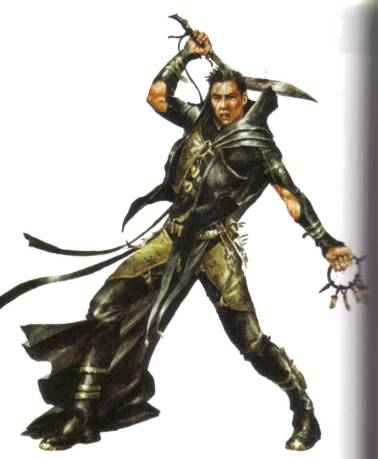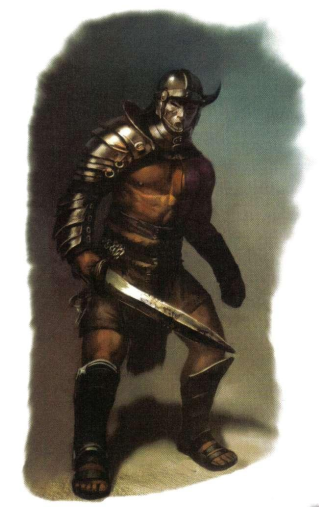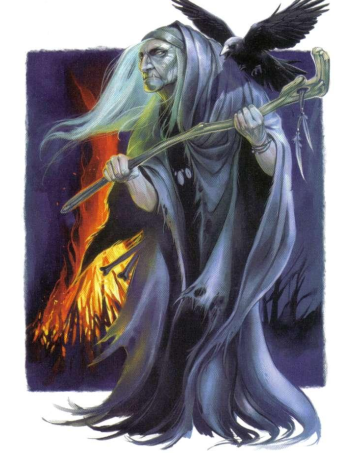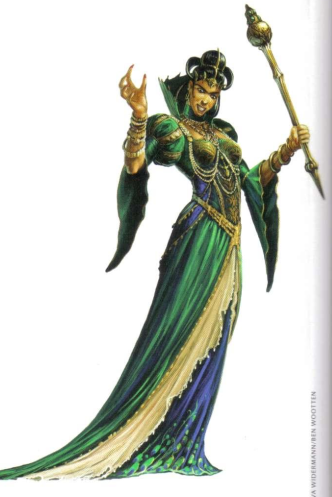Let's Read the 4e Monster Manual/Vault: Human
As we saw in the Monster Manual Let’s Read, Fourth Edition makes the usual D&D human description a little more specific. They’re the mortal people without a patron deity, which makes their outlooks on life very varied and leaves extra room in their hearts that can be filled with extreme dedication to any number of causes. Therefore, humans can produce some of the world’s greatest heroes as well as its most depraved villains.
This MM2 entry brings us a huge grab bag of human stat blocks. Most of them are the usual Unaligned people that can be repurposed as either allies or enemies, but a few are Evil or Chaotic Evil and meant to always be used as threats.
Numbers-wise, they have absolutely no common traits beyond being Medium Natural Humanoids with a ground speed of 6. You can easily take a human stat block and make it into a member of another species by adding the relevant signature ability to them (Goblin Tactics, Elven Accuracy, Savage Demise, Fey Step…).
Human Cavalier
An armored knight that fights with lance and sword. It’s highly recommended that you give them a mount when building your encounters, though they can give a good account of themselves on foot as well. Horses and griffons are the most common cavalier mounts.
The Cavalier is a Level 7 Soldier (Leader) with 78 HP. Their basic attack is a sword strike that damages and marks on a hit, and they can exploit the mark with two different interrupt abilities. Champion’s Retort is at-will and allows the knight to make a slightly weaker attack against a marked enemy who decides to ignore the mark. Hasty Parry is an encounter power that forces the enemy to target the knight instead, and gives the knight a +3 AC bonus against that attack.
When mounted, the knight can also attack with a Lance that damages and knocks prone on a hit. The text doesn’t say it can be used as part of a charge, but it really should have this ability.
Human Diabolist

A warlock-type who’s in tight with the forces of Hell, and wields fire-and-brimstone themed magic to achieve their Evil ends.
The diabolist is Level 20 Artillery with 147 HP, powerful enough to be encountered alongside groups of high-end devils. Their main weapon and implement is a kukri that does a mix of physical and fire damage. Like all attacks in this book it needs a damage boost, but make sure its roll is still a fistful of d6s because this attack has the Brutal property. This means you re-roll any dice that show a 1 until they show something else.
Their attack magic is all about Darkfire, in an “at-will single-target” and “area encounter power” versions. It does fire and necrotic damage, and the area version also does ongoing fire and necrotic damage (save ends).
For enemies who get a bit closer, the diabolist can use a Sulfurous Flash attack that deals fire damage and gives the caster concealment against the target until the end of the caster’s next turn. If attacked, the diabolist can use Infernal Deflection (recharge 5+) as an interrupt to take half damage from the attack and deal an automatic 15 fire damage to the attacker.
All of these attacks can be enhanced by Hell Blight, a minor action that automatically makes an enemy in sight “blighted”. If a blighted enemy takes fire damage from the diabolist, they can’t recover HP until the end of the diabolist’s next turn. The blight ends when the fight does, or when the diabolist blights someone else. This makes focusing their fire on a sincle PC at a time a very effective tactic.
Finally, the Life From Fire passive trait gives the diabolist 10 temporary HP whenever they take fire damage from any source.
Human Dire Beast Hunter
Someone has to protect all those scattered villages if no PCs are around to help! This hunter is Level 9 Artillery with 76 HP, wielding a spear, a crossbow with poisoned bolts, and a net.
The net is a Ranged 3 attack that does no damage and restrains (save ends). The crossbow has good range and its bolts have an ongoing poison damage (save ends) rider. The spear is there for emergencies, because its best to hunt dire beasts from a distance.
The hunter is not meant to be alone. It should be encountered either as part of a sizable NPC hunting party, or attached to the PCs as an ally for a particularly tough hunt.
Human Dread Assassin
An epic-level assassin armed with a dreadful sword and with spells of poison and darkness. The perfect person for the job when that job is to kill a king or emperor. Though they’re unaligned, their clientele is unlikely to be very nice.
The assassin is a Level 22 Lurker with 161 HP and a speed of 7. Their Zealot’s Scimitar is a High-Crit weapon that also deals ongoing poison and necrotic damage (save ends). They can use a power named Cloak of Zeal as a move action to shift 3 squares and gain concealment until the end of their next turn.
While the assassin has cover or concealment, they can use Deadly Blade (recharge 5+) as a minor action to make is so their next attack has combat advantage and deals 5d6 extra damage on a hit. And finally, Assassin’s Determination triggers when they’re bloodied and either immediately recharges Deadly Blade or (if it’s charged already) heals them for 20 HP.
I guess the idea is that this is a deadly foe that will never stop trying to kill you until they succeed, but you should really boost their damage for that to be true. Also, since they’re regulars you should expect these epic ninjas to team up with either other assassins, or with some distracting heavies.
Human Gladiator

This gladiator is described by the book as a “consumate athlete”, which isn’t really the term I’d use to refer to someone forced to fight in deathmatches for the amusement of a bloodthirsty crowd. Still, some of them might end up becomming bloodsport celebrities, and this one is powerful enough to fit that role.
This particular individual is a Level 14 Elite Soldier with 276 HP, so we’re either looking at a Spartacus in the making or at the reigning champion of the arena that must be taken down before the revolt can start. He wears armor equivalent to scale and carries a light shield and a gladius.
The gladiator has a Fighting Focus aura (1) that marks enemies who start their turns inside, lasting until the start of their next turns. It’s a lot like the Essential Knight’s Defender Aura, with a bit more stickiness.
That gladius can be used to make melee basic attacks, and in a Gladius Display that attacks a Close Burst 1 and does the same damage. This is supplemented by a variety of dirty tricks. They’re all minor actions, and though none of them do damage they inflict a variety of conditions.
Knock to the Dirt is an encounter power that targets Fortitude and knocks prone; Sand in the Eyes is another encounter power that targets fortitude, and causes blindness (save ends). Well-Placed Kick is recharge 5+, targets Reflex, and both slows and dazes the target (save ends). I bet it targets the… knee. Yeah, that’d do it.
That’s the sort of fighting style that’d mark you as a heel in wrestling, but since the gladiator fights in actual life or death matches I’d say it’s just good sense.
Human Hexer

Perfect for playing the part of a sinister witch or a seer whose dire prophecies go unheard. The hexer is a Level 7 Controller with 77 HP, wearing robes and wielding a staff.
The hexer is extremely weak in terms of damage, and is meant to be used alongside monsters who are better in that area. They have some interesting control options, though.
Their only melee attack is a weak bonk with the staff, but insted of bothering with it they’re going to stay away and open up with Hex, a minor action that targets all enemies in a Close Burst 10. That’s guaranteed to cover all PCs unless one of them is a sniper ranger or something. It’s an attack against Will, and a hit means the target is hexed. Hexed targets have a -2 penalty to damage the hexer, and become valid targets for the hexer’s other spells.
One of them is Capricious Earth (encounter), a big area burst that targets Will, does a bit of damage, slides targets 3 squares, and knocks them prone.
The other one is Beast Curse (recharge 4+), a ranged spell that targets Fortitude and turns the target into a Tiny creature until the end of the hexer’s next turn. While in this state the target cannot use powers. Yes, this does include basic attacks, so your Slayer won’t turn into a surprisingly deadly frog.
Human Insane Noble

Not to be confused with the standard Human Noble, shown later. The picture is pretty much a caricature of Carlota Joaquina, a historical figure who was rather unpleasant but not epic-level.
The Insane Noble wears finery and wields a scepter, but as a Level 23 Elite Skirmisher it doesn’t need much more than that to ruin your day. Sheer Madness makes them immune to opportunity attacks. The scepter is a basic attack, and Flurry of Madness allows the noble to shift 6 squares and make a scepter attack against every enemy they pass by during the shift. These traits and abilities combine to make them a combatant that never stands still, scuttling about the battlefield with alarming alacrity.
When the noble is first bloodied, Ignoble Fury triggers and lets them bonk everyone in a Close Burst 1 with a scepter attack that also knocks targets prone on a hit.
Human Javelin Dancer
A specialized martial artist, lightly armored and wielding a spear for close combat and a brace of javelins for range. Their Skirmisher trait allows them to do increased damage if they move at least 4 squares before attacking, and Adept Retreat makes them not grant combat advantage when running. “Running” is something everyone can do, greatly increasing their Move at the cost of granting combat advantage. That’s what the dancer ignores.
In addition to basic attacks with the spear or a thrown javelin, the dancer can also make a Mobile Attack at will, shifting 3 squares and attacking with the spear.
Human Knife Fighter
Knife fighters are rogue-types that are much more focused on acrobatic stabbing than on other types of crime, which makes them quite similar to PC rogues when you think about it. They also do well in the role of a knife-focused martial artist, or the classic super-dangerous lieutenant for a criminal gang whose actual boss isn’t a fighter.
This knife fighter is a Level 7 Elite Skirmisher with 162 HP. They go unarmored (which doesn’t affect their defenses, since they’re all based on level), and are equipped with a dagger and a net.
The net is probably a typo, since none of the fighter’s abilities use it, but the knife is a Wounding Dagger with an ongoing damage rider and the High-Crit property. It can also be used in an attack named Dance of the Knife, where the knife fighter makes two dagger attacks and shifts 2 squares between them.
All of these attacks deal extra damage when they have combat advantage, and they can also use Peerless Tumbler (recharge 5+) to shift 4 squares while ignoring difficult terrain.
Very skirmishery, and goes very well with a pack of soldier monsters with marking and punishing abilities.
Human Mystagogue
A divine spellcaster who delves into divine mysteries few mortals can understand. Their magic focuses a lot on mind- and perception-affecting effects.
Mystagogues are Level 20 Controllers with the Leader keyword and 188 HP. They wear robes and carry a holy symbol - all of their attacks are magic.
The basic melee attack is Mystery’s Touch (vs. Reflex), which deals psychic damage and inflicts a -2 penalty to attack the mystagogue until the end if their next turn. At range they use Bend Perception (ranged 20 vs. Will), which deals psychic damage, slows, and inflicts a -2 penalty to all attacks and saves until the end of the mystagogue’s next turn.
Their special attack is Awestrike (close burst 5 vs will), which does the same damage as Bend Perception to all it hits, and also slides the targets 6 squares and dazes them (save ends). The mystagogue also chooses one ally in the area to slide 6 squares and heal for 10 HP.
Finally, the mystagogue can use a Veil of Inscrutability as a reaction to being hit by a melee or ranged attack. This allows them to shift 2 squares and gain a +2 bonus to AC and Reflex for a turn.
As opposition, mystagogues pair well with enemies who can exploit combat advantage or (save ends) effects.
Human Noble
Not to be confused with the Insane Noble from a few entries ago. This type of noble can still be pretty horrible, but not the “epic-level scuttling nightmare” kind of horrible. They’re Level 5 Controllers with the Leader keyword and 60 HP.
The Noble wears mail and wields a longsword and a light shield. Their sword strikes are nothing special, and their actual superpower is ordering people around. It’s very much meant to be encountered alongside its bodyguard detail, which will be made up of more competent fighters. In other words, this is the NPC version of the Lazy Warlord.
The noble is Protected by their allies, and gains a +2 to all defenses when adjacent to at least one of them. Appoint Champion is an at-will order that allows an ally to make a basic attack and shift 1 square before or after it. Inspirational Authority is an encounter power that allows one of those allies to use any of their attacks as a free action.
The noble can also order enemies around. Urge Hesitation is an attack against Will that, on a hit, prevents the target from using a standard action in its next turn.
Human Pirate
Yarrr! Pirates are Level 9 Skirmishers with 95 HP, armed with cutlasses. They’re pretty fast, with a Speed of 7 and a Rigging Monkey ability that gives them a climb speed of 7 for a turn once per encounter.
Their basic attack is a Cutlass strike with no additional riders, but they’re extra-good at flanking: Scurvy Dog’s Flank gives them an extra +1 to hit and +2d6 bonus damage to all attacks against a flanked target. This stacks with combat advantage for a total of +3 to hit.
Their tactics section says they like to stay near the water or near the edge of the boat if this is a boarding action, but I see no reason for this.
Human Pirate Captain

Double Yarrr! The captain is a Level 10 Soldier with the Leader keyword and 104 HP. It’s clearly meant to be used alongside a bunch of Pirates and perhaps a small horde of minions.
Their Cutlass attacks have a slow (save ends) rider, and they have the same Rigging Monkey and Scurvy Dog’s Flank abilities as the rest of the crew. Captains complement their swordplay with occasional bouts of Vicious Mockery (minor action; recharge 6+). This doesn’t require an attack roll and causes a nearby enemy to provoke an opportunity attack from one of the captain’s allies. When first bloodied, they shout out a Call to Arms that allows all allies within 10 squares to make a basic melee attack or shift 3 squares as a free action.
Human Slaver
One of the few explicitly Evil stat blocks in this entry, the slaver is an unpleasant villain that fights with a mace and a scourge. Their focus is on immobilizing enemies for capture, and on inflicting pain. They’re level 8 Brutes with 102 HP.
Their basic attack is Thump and Lash, which deals damage and inflicts a -2 attack penalty for a turn. They can also use the scourge to perform a Slaver’s Tangle maneuver (recharge 4+) that does all of the above and also immobilizes for a turn.
Slavers are meant to be use as part of larger capture teams featuring one or more of them plus an assortment of other goons.
Final Impressions
Between the first Monster Manual, the Vault, and the MM2, you have enough human stat blocks that you can include one or more of them in any encounter that demands sapient humanoid opposition. The PCs themselves are proof that humans work well with members of any other sapient species that share their individual goals.
These “generic” stat blocks also work as seasoning for more specialized groups, like cultists. It might surprise the PCs a bit if the guy holding the sacrificial dagger is an elite knife-fighter instead of a squishy caster, for example.